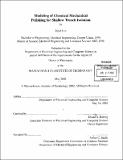| dc.contributor.advisor | Duane S. Boning. | en_US |
| dc.contributor.author | Lee, Brian, 1975- | en_US |
| dc.contributor.other | Massachusetts Institute of Technology. Dept. of Electrical Engineering and Computer Science. | en_US |
| dc.date.accessioned | 2006-03-24T18:01:58Z | |
| dc.date.available | 2006-03-24T18:01:58Z | |
| dc.date.copyright | 2002 | en_US |
| dc.date.issued | 2002 | en_US |
| dc.identifier.uri | http://hdl.handle.net/1721.1/29907 | |
| dc.description | Thesis (Ph. D.)--Massachusetts Institute of Technology, Dept. of Electrical Engineering and Computer Science, 2002. | en_US |
| dc.description | Includes bibliographical references (p. 195-201). | en_US |
| dc.description.abstract | This thesis presents the nonlinear analysis, design, fabrication, and testing of an axial-gap magnetic induction micro machine, which is a two-phase planar motor in which the rotor is suspended above the stator via mechanical springs, or tethers. The micro motor is fabricated from thick layers of electroplated NiFe and copper, by our collaborators at Georgia Institute of Technology. The rotor and the stator cores are 4 mm in diameter each, and the entire motor is about 2 mm thick. During fabrication, SU-8 epoxy is used as a structural mold material for the electroplated cores. The tethers are designed to be compliant in the azimuthal direction, while preventing axial deflections and maintaining a constant air gap. This enables accurate measurements of deflections within the rotor plane via a computer microvision system. The small scale of the magnetic induction micro machine, in conjunction with the good thermal contact between its electroplated stator layers, ensures an isothermal device which can be cooled very effectively. Current densities over 109 A/m2 simultaneously through each phase is repeatedly achieved during experiments; this density is over two orders of magnitude larger than what can be achieved in conventional macro-scale machines. | en_US |
| dc.description.abstract | (cont.) More than 5 Nm of torque is obtained for an air gap of about 5 zm, making this micro motor the highest torque density micro-scale magnetic machine to date. About 0.3 buNm for the large air gap of 70 m is also achieved in systematic tests that reveal the influence of strong eddy-currents and associated nonlinear saturation within the micro motor Eddy-current effects are modeled using a finite-difference vector potential formulation. Its results demonstrate the presence of flux crowding on the stator surface, which leads to heavy saturation. To capture saturation effects, a fully nonlinear finite-difference time-domain simulation is developed to solve Maxwell's Equations within the computational space of the micro machine. To mitigate the inherent stiffness in the partial differential equations, the speed of light is artificially reduced by five orders of magnitude, taking special care that assumptions of magnetoquasistatic behavior are still met. The results from this model are in very good agreement with experimental data from the tethered magnetic induction micro motor. | en_US |
| dc.description.statementofresponsibility | by Brian Lee. | en_US |
| dc.format.extent | 201 p. | en_US |
| dc.format.extent | 8650279 bytes | |
| dc.format.extent | 8650088 bytes | |
| dc.format.mimetype | application/pdf | |
| dc.format.mimetype | application/pdf | |
| dc.language.iso | eng | en_US |
| dc.publisher | Massachusetts Institute of Technology | en_US |
| dc.rights | M.I.T. theses are protected by copyright. They may be viewed from this source for any purpose, but reproduction or distribution in any format is prohibited without written permission. See provided URL for inquiries about permission. | en_US |
| dc.rights.uri | http://dspace.mit.edu/handle/1721.1/7582 | |
| dc.subject | Electrical Engineering and Computer Science. | en_US |
| dc.title | Modeling of chemical mechanical polishing for shallow trench isolation | en_US |
| dc.type | Thesis | en_US |
| dc.description.degree | Ph.D. | en_US |
| dc.contributor.department | Massachusetts Institute of Technology. Department of Electrical Engineering and Computer Science | |
| dc.identifier.oclc | 51550156 | en_US |
